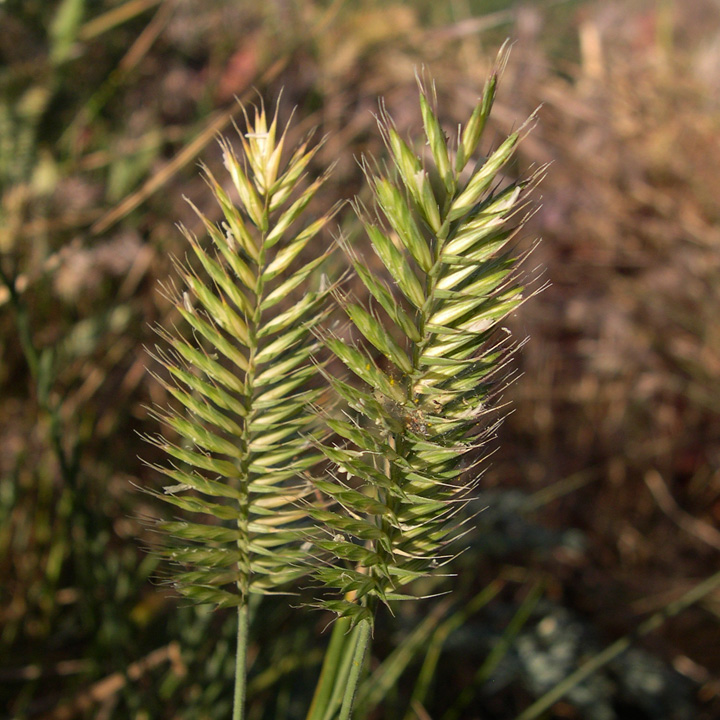
|
Family: Poaceae |
Flora of North America 24: 277; Flora of China 22: 437 Plants perennial; usually densely to loosely clumped, sometimes rhizomatous. Culms 25-100 cm tall, usually erect, sometimes geniculate at the base. Leaves: sheaths glabrous or hairy, smooth or scabrous, those of cauline leaves open, those of vegetative shoots usually closed most of their length; auricles usually present on basal leaves, lanceolate; ligules to 1.5 mm long, membranous, rounded to truncate, often erose. blades 1-9 mm wide, flat or involute, surfaces glabrous or not, smooth or scabrous. Inflorescence distichous, spikelike, 1.3-15 cm long, 4-25 mm wide, linear-oblong to ovate in outline; rachis tough, pubescent; basal internodes as long or slightly longer than middle internodes, middle internodes 2-8 mm long. Spikelets 1 per node, 3 or more times as long as the adjacent internode, 2-8 mm wide, sessile, laterally compressed, strongly ascending to strongly diverging from the rachis, with 3-16 florets; disarticulation below the florets. Glumes shorter than the adjacent lemmas, linear to lanceolate or lance-ovate, 1-5-veined, strongly and asymmetrically1-keeled to the base, keel glabrous or hairy, hairs not in tufts, tip tapered, acuminate to awned, awn up to 6 mm long; lemmas lanceolate-oblong, leathery, glabrous or hairy, 5-7-veined, keeled at least distally, keels usually pilose, occasionally smooth and glabrous, tip acute or awned, awn to 4.5 mm long; palea from slightly shorter to slightly longer than the lemma, tip 2-toothed; lodicules with ciliate margins; anthers 3, 3-5 mm long yellow. Caryopses usually falling with the lemma and palea attached. Taxonomic comments: Agropyron is now restricted to what are often called the "Crested wheatgrasses", a group that was recognized as distinctive even when the genus was interpreted as including all members of the tribe with a single spikelet per node. In the second half of the twnetieth century it was found that they were also genomically distinct, being diploids, tetraploids, and hexaploids based on the P genome. Although the boundaries of the genus are clear, there is much less agreement concerning the number of species that should be recognized. Tzvelev recognized 10 species in the former Soviet Union; Chi et al. (1998) in their treatment of the genus recognized 13 species; Bing Cao Shu (2007) estimated the number of species as 15. There has been no comprehensive study of the genus based on seed from natural populations. Distribution: Agropyon is native to Eurasia, primarily Central Asia. It has become widely established in western North America where it has been sown for soil stabilization, rangeland restoration, and on abandoned farmland. Reasons for its widespread use include its ability to establish in a wide range of habitats and its palatibility to livestock. Spikelets solitary at each node of a bilateral spike, borne flatwise to the flexuous or zigzag rachis, several-fld, eventually disarticulating above the glumes and between the florets; internodes of the rachis very short, mostly 0.5-2(-3) mm; glumes strongly and somewhat excentrically keeled, the keel commonly produced into a short awn; lemmas firm, distally keeled and usually short-awned, with 1 or 2 pairs of less prominent lateral veins; anthers ±elongate, (2-)3-5 mm; outcrossing perennial bunchgrasses. One broadly defined (as here) or several closely allied spp., native to Eurasia. Gleason, Henry A. & Cronquist, Arthur J. 1991. Manual of vascular plants of northeastern United States and adjacent Canada. lxxv + 910 pp. ©The New York Botanical Garden. All rights reserved. Used by permission. |



